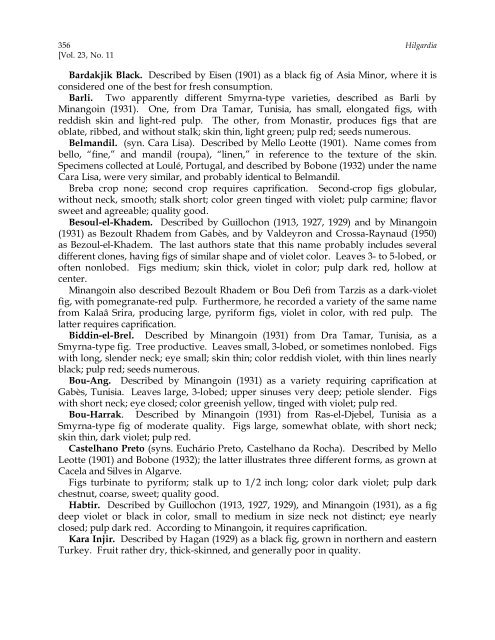Fig Varieties: A Monograph - uri=ucce.ucdavis
Fig Varieties: A Monograph - uri=ucce.ucdavis
Fig Varieties: A Monograph - uri=ucce.ucdavis
Create successful ePaper yourself
Turn your PDF publications into a flip-book with our unique Google optimized e-Paper software.
356 Hilgardia<br />
[Vol. 23, No. 11<br />
Bardakjik Black. Described by Eisen (1901) as a black fig of Asia Minor, where it is<br />
considered one of the best for fresh consumption.<br />
Barli. Two apparently different Smyrna-type varieties, described as Barli by<br />
Minangoin (1931). One, from Dra Tamar, Tunisia, has small, elongated figs, with<br />
reddish skin and light-red pulp. The other, from Monastir, produces figs that are<br />
oblate, ribbed, and without stalk; skin thin, light green; pulp red; seeds numerous.<br />
Belmandil. (syn. Cara Lisa). Described by Mello Leotte (1901). Name comes from<br />
bello, “fine,” and mandil (roupa), “linen,” in reference to the texture of the skin.<br />
Specimens collected at Loulé, Portugal, and described by Bobone (1932) under the name<br />
Cara Lisa, were very similar, and probably identical to Belmandil.<br />
Breba crop none; second crop requires caprification. Second-crop figs globular,<br />
without neck, smooth; stalk short; color green tinged with violet; pulp carmine; flavor<br />
sweet and agreeable; quality good.<br />
Besoul-el-Khadem. Described by Guillochon (1913, 1927, 1929) and by Minangoin<br />
(1931) as Bezoult Rhadem from Gabès, and by Valdeyron and Crossa-Raynaud (1950)<br />
as Bezoul-el-Khadem. The last authors state that this name probably includes several<br />
different clones, having figs of similar shape and of violet color. Leaves 3- to 5-lobed, or<br />
often nonlobed. <strong>Fig</strong>s medium; skin thick, violet in color; pulp dark red, hollow at<br />
center.<br />
Minangoin also described Bezoult Rhadem or Bou Defi from Tarzis as a dark-violet<br />
fig, with pomegranate-red pulp. Furthermore, he recorded a variety of the same name<br />
from Kalaâ Srira, producing large, pyriform figs, violet in color, with red pulp. The<br />
latter requires caprification.<br />
Biddin-el-Brel. Described by Minangoin (1931) from Dra Tamar, Tunisia, as a<br />
Smyrna-type fig. Tree productive. Leaves small, 3-lobed, or sometimes nonlobed. <strong>Fig</strong>s<br />
with long, slender neck; eye small; skin thin; color reddish violet, with thin lines nearly<br />
black; pulp red; seeds numerous.<br />
Bou-Ang. Described by Minangoin (1931) as a variety requiring caprification at<br />
Gabès, Tunisia. Leaves large, 3-lobed; upper sinuses very deep; petiole slender. <strong>Fig</strong>s<br />
with short neck; eye closed; color greenish yellow, tinged with violet; pulp red.<br />
Bou-Harrak. Described by Minangoin (1931) from Ras-el-Djebel, Tunisia as a<br />
Smyrna-type fig of moderate quality. <strong>Fig</strong>s large, somewhat oblate, with short neck;<br />
skin thin, dark violet; pulp red.<br />
Castelhano Preto (syns. Euchário Preto, Castelhano da Rocha). Described by Mello<br />
Leotte (1901) and Bobone (1932); the latter illustrates three different forms, as grown at<br />
Cacela and Silves in Algarve.<br />
<strong>Fig</strong>s turbinate to pyriform; stalk up to 1/2 inch long; color dark violet; pulp dark<br />
chestnut, coarse, sweet; quality good.<br />
Habtir. Described by Guillochon (1913, 1927, 1929), and Minangoin (1931), as a fig<br />
deep violet or black in color, small to medium in size neck not distinct; eye nearly<br />
closed; pulp dark red. According to Minangoin, it requires caprification.<br />
Kara Injir. Described by Hagan (1929) as a black fig, grown in northern and eastern<br />
Turkey. Fruit rather dry, thick-skinned, and generally poor in quality.
















![Fig Trees in North Carolina [Archive] - IDigMyGarden ... - Figs 4 Fun](https://img.yumpu.com/26905320/1/190x245/fig-trees-in-north-carolina-archive-idigmygarden-figs-4-fun.jpg?quality=85)